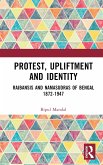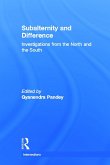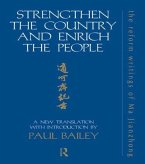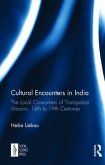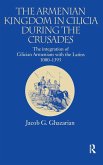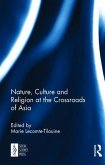The Cultural Heritage of Nagaland
Herausgeber: Chophy, G Kanato; Chaudhuri, Sarit K
The Cultural Heritage of Nagaland
Herausgeber: Chophy, G Kanato; Chaudhuri, Sarit K
- Gebundenes Buch
- Merkliste
- Auf die Merkliste
- Bewerten Bewerten
- Teilen
- Produkt teilen
- Produkterinnerung
- Produkterinnerung
This volume gives an in-depth account of cultural heritage of Nagaland covering important themes like cultural beliefs, traditional knowledge, material culture, and social institutions.
Andere Kunden interessierten sich auch für
![Protest, Upliftment and Identity Protest, Upliftment and Identity]() Bipul MandalProtest, Upliftment and Identity165,99 €
Bipul MandalProtest, Upliftment and Identity165,99 €![Subalternity and Difference Subalternity and Difference]() Subalternity and Difference180,99 €
Subalternity and Difference180,99 €![The Indian Constituent Assembly The Indian Constituent Assembly]() The Indian Constituent Assembly180,99 €
The Indian Constituent Assembly180,99 €![Strengthen the Country and Enrich the People Strengthen the Country and Enrich the People]() Paul BaileyStrengthen the Country and Enrich the People115,99 €
Paul BaileyStrengthen the Country and Enrich the People115,99 €![Cultural Encounters in India Cultural Encounters in India]() Heike LiebauCultural Encounters in India187,99 €
Heike LiebauCultural Encounters in India187,99 €![The Armenian Kingdom in Cilicia During the Crusades The Armenian Kingdom in Cilicia During the Crusades]() Jacob GhazarianThe Armenian Kingdom in Cilicia During the Crusades179,99 €
Jacob GhazarianThe Armenian Kingdom in Cilicia During the Crusades179,99 €![Nature, Culture and Religion at the Crossroads of Asia Nature, Culture and Religion at the Crossroads of Asia]() Nature, Culture and Religion at the Crossroads of Asia187,99 €
Nature, Culture and Religion at the Crossroads of Asia187,99 €-
-
-
This volume gives an in-depth account of cultural heritage of Nagaland covering important themes like cultural beliefs, traditional knowledge, material culture, and social institutions.
Hinweis: Dieser Artikel kann nur an eine deutsche Lieferadresse ausgeliefert werden.
Hinweis: Dieser Artikel kann nur an eine deutsche Lieferadresse ausgeliefert werden.
Produktdetails
- Produktdetails
- Verlag: Taylor & Francis
- Seitenzahl: 350
- Erscheinungstermin: 22. Dezember 2022
- Englisch
- Abmessung: 216mm x 140mm x 21mm
- Gewicht: 553g
- ISBN-13: 9781032424477
- ISBN-10: 1032424478
- Artikelnr.: 65891331
- Herstellerkennzeichnung
- Libri GmbH
- Europaallee 1
- 36244 Bad Hersfeld
- gpsr@libri.de
- Verlag: Taylor & Francis
- Seitenzahl: 350
- Erscheinungstermin: 22. Dezember 2022
- Englisch
- Abmessung: 216mm x 140mm x 21mm
- Gewicht: 553g
- ISBN-13: 9781032424477
- ISBN-10: 1032424478
- Artikelnr.: 65891331
- Herstellerkennzeichnung
- Libri GmbH
- Europaallee 1
- 36244 Bad Hersfeld
- gpsr@libri.de
G. Kanato Chophy is Assistant Professor at Department of Anthropology, Dibrugarh University, Dibrugarh, Assam. He has earlier been Post-Doctoral Fellow at the Centre of Excellence, Centre for North-East India Studies, Utkal University, Bhubaneswar, Odisha. He is the author of Christianity and Politics in Tribal India: Baptist Missionaries and Naga Nationalism (2021), and Constructing the Divine: Religion and World View of a Naga Tribe in North-East India (2019). Sarit K. Chaudhuri was the former Director of IGRMS, Bhopal, and is currently working as Professor & Dean, Faculty of Social Sciences at the Department of Anthropology, Rajiv Gandhi University, Rono Hills, Arunachal Pradesh.
Introduction PART I: HERITAGE, BELIEFS AND HISTORY 1. An Overview of
Cultural Heritage of Nagaland 2. Clan, Village and the Angami Language 3.
Colonial and Post-colonial Anthropology among the Nagas 4. Interaction
between Colonial Agencies and Naga World-view: A Study of Social Change
among the Ao Nagas, 1870-1955 5. History, Heritage and Identity: A Study
onthe Kukis of Naga Hills, 1832-1963 6. Situating the Oral Narratives and
History fromthe Battle of Kohima in the Second World War PART II: MEMORY
CULTURE, ORAL TRADITION AND INTANGIBLE CULTURAL HERITAGE 7. Dzükou: The
Heritage and Ethereal Garden of the Nagas 8. Sacred Grove: A Culture
Heritage of Nagaland 9. Changki's Traditional Practice of Leopard
Huntingand its Implication on the Nature of Culture 10. Festival and
Agrarian Socio-economic Formation:The Case of the Chakhesang Naga of
Nagaland 11. Preservation of Intangible Cultural Heritage: A Comparison
between the Nagas and the Indigenous People of East Africa PART III:
ARTEFACTS, MATERIAL CULTURE AND MNEMONIC OBJECTS 12. Gendered Body,
Performance and Inscription:Shifted Meanings of Personal Adornmentsamong
the Sumi Naga of Nagaland 13. Symbolism of Hair and Ornamentation 14.
Cultural Values Embedded in Morung 15. Making of a Naga Heritage
Cultural Heritage of Nagaland 2. Clan, Village and the Angami Language 3.
Colonial and Post-colonial Anthropology among the Nagas 4. Interaction
between Colonial Agencies and Naga World-view: A Study of Social Change
among the Ao Nagas, 1870-1955 5. History, Heritage and Identity: A Study
onthe Kukis of Naga Hills, 1832-1963 6. Situating the Oral Narratives and
History fromthe Battle of Kohima in the Second World War PART II: MEMORY
CULTURE, ORAL TRADITION AND INTANGIBLE CULTURAL HERITAGE 7. Dzükou: The
Heritage and Ethereal Garden of the Nagas 8. Sacred Grove: A Culture
Heritage of Nagaland 9. Changki's Traditional Practice of Leopard
Huntingand its Implication on the Nature of Culture 10. Festival and
Agrarian Socio-economic Formation:The Case of the Chakhesang Naga of
Nagaland 11. Preservation of Intangible Cultural Heritage: A Comparison
between the Nagas and the Indigenous People of East Africa PART III:
ARTEFACTS, MATERIAL CULTURE AND MNEMONIC OBJECTS 12. Gendered Body,
Performance and Inscription:Shifted Meanings of Personal Adornmentsamong
the Sumi Naga of Nagaland 13. Symbolism of Hair and Ornamentation 14.
Cultural Values Embedded in Morung 15. Making of a Naga Heritage
Introduction PART I: HERITAGE, BELIEFS AND HISTORY 1. An Overview of
Cultural Heritage of Nagaland 2. Clan, Village and the Angami Language 3.
Colonial and Post-colonial Anthropology among the Nagas 4. Interaction
between Colonial Agencies and Naga World-view: A Study of Social Change
among the Ao Nagas, 1870-1955 5. History, Heritage and Identity: A Study
onthe Kukis of Naga Hills, 1832-1963 6. Situating the Oral Narratives and
History fromthe Battle of Kohima in the Second World War PART II: MEMORY
CULTURE, ORAL TRADITION AND INTANGIBLE CULTURAL HERITAGE 7. Dzükou: The
Heritage and Ethereal Garden of the Nagas 8. Sacred Grove: A Culture
Heritage of Nagaland 9. Changki's Traditional Practice of Leopard
Huntingand its Implication on the Nature of Culture 10. Festival and
Agrarian Socio-economic Formation:The Case of the Chakhesang Naga of
Nagaland 11. Preservation of Intangible Cultural Heritage: A Comparison
between the Nagas and the Indigenous People of East Africa PART III:
ARTEFACTS, MATERIAL CULTURE AND MNEMONIC OBJECTS 12. Gendered Body,
Performance and Inscription:Shifted Meanings of Personal Adornmentsamong
the Sumi Naga of Nagaland 13. Symbolism of Hair and Ornamentation 14.
Cultural Values Embedded in Morung 15. Making of a Naga Heritage
Cultural Heritage of Nagaland 2. Clan, Village and the Angami Language 3.
Colonial and Post-colonial Anthropology among the Nagas 4. Interaction
between Colonial Agencies and Naga World-view: A Study of Social Change
among the Ao Nagas, 1870-1955 5. History, Heritage and Identity: A Study
onthe Kukis of Naga Hills, 1832-1963 6. Situating the Oral Narratives and
History fromthe Battle of Kohima in the Second World War PART II: MEMORY
CULTURE, ORAL TRADITION AND INTANGIBLE CULTURAL HERITAGE 7. Dzükou: The
Heritage and Ethereal Garden of the Nagas 8. Sacred Grove: A Culture
Heritage of Nagaland 9. Changki's Traditional Practice of Leopard
Huntingand its Implication on the Nature of Culture 10. Festival and
Agrarian Socio-economic Formation:The Case of the Chakhesang Naga of
Nagaland 11. Preservation of Intangible Cultural Heritage: A Comparison
between the Nagas and the Indigenous People of East Africa PART III:
ARTEFACTS, MATERIAL CULTURE AND MNEMONIC OBJECTS 12. Gendered Body,
Performance and Inscription:Shifted Meanings of Personal Adornmentsamong
the Sumi Naga of Nagaland 13. Symbolism of Hair and Ornamentation 14.
Cultural Values Embedded in Morung 15. Making of a Naga Heritage


